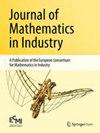Network-inspired versus Kozeny–Carman based permeability-porosity relations applied to Biot’s poroelasticity model
IF 1.7
Q3 MATHEMATICS, INTERDISCIPLINARY APPLICATIONS
引用次数: 11
Abstract
Water injection in the aquifer induces deformations in the soil. These mechanical deformations give rise to a change in porosity and permeability, which results in non-linearity of the mathematical problem. Assuming that the deformations are very small, the model provided by Biot’s theory of linear poroelasticity is used to determine the local displacement of the skeleton of a porous medium, as well as the fluid flow through the pores. In this continuum scale model, the Kozeny–Carman equation is commonly used to determine the permeability of the porous medium from the porosity. The Kozeny–Carman relation states that flow through the pores is possible at a certain location as long as the porosity is larger than zero at this location in the aquifer. However, from network models it is known that percolation thresholds exist, indicating that the permeability will be equal to zero if the porosity becomes smaller than these thresholds. In this paper, the relationship between permeability and porosity is investigated. A new permeability-porosity relation, based on the percolation theory, is derived and compared with the Kozeny–Carman relation. The strongest feature of the new approach is related to its capability to give a good description of the permeability in case of low porosities. However, with this network-inspired approach small values of the permeability are more likely to occur. Since we show that the solution of Biot’s model converges to the solution of a saddle point problem for small time steps and low permeability, we need stabilisation in the finite element approximation.网络启发与基于Kozeny-Carman的渗透率-孔隙度关系应用于Biot的孔隙弹性模型
含水层注水引起土壤变形。这些机械变形引起孔隙度和渗透率的变化,从而导致数学问题的非线性。假设变形非常小,利用Biot的线性孔隙弹性理论提供的模型来确定多孔介质骨架的局部位移,以及流体在孔隙中的流动。在这种连续尺度模型中,通常使用Kozeny-Carman方程从孔隙度来确定多孔介质的渗透率。Kozeny-Carman关系表明,在含水层的某一位置,只要孔隙度大于零,流体就有可能通过孔隙。然而,从网络模型可知,渗透阈值是存在的,表明当孔隙度小于这些阈值时,渗透率将等于零。本文研究了渗透率与孔隙度的关系。基于渗流理论,推导了一种新的渗透率-孔隙度关系,并与Kozeny-Carman关系进行了比较。新方法的最大特点在于它能够很好地描述低孔隙度情况下的渗透率。然而,采用这种受网络启发的方法,更有可能出现较小的渗透率值。由于我们证明了Biot模型的解收敛于小时间步长和低渗透率的鞍点问题的解,因此我们需要在有限元近似中进行稳定。
本文章由计算机程序翻译,如有差异,请以英文原文为准。
求助全文
约1分钟内获得全文
求助全文
来源期刊

Journal of Mathematics in Industry
MATHEMATICS, INTERDISCIPLINARY APPLICATIONS-
CiteScore
5.00
自引率
0.00%
发文量
12
审稿时长
13 weeks
 求助内容:
求助内容: 应助结果提醒方式:
应助结果提醒方式:


